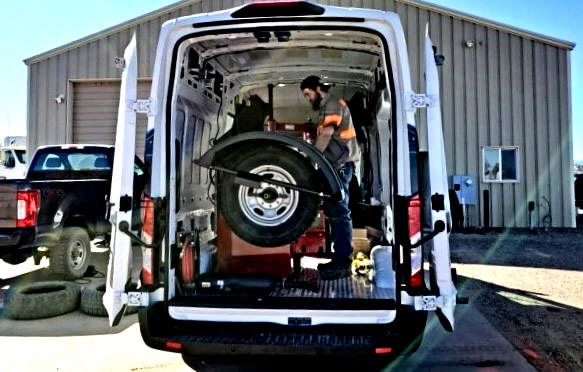Tire Solution: Proven Methods for Optimum Tire Upkeep and Care
Keeping optimal tire problem is vital for both safety and efficiency of any lorry. From making certain appropriate tire stress to routine turning and alignment, there are tried and tested techniques that can significantly prolong the life-span of your tires and improve overall driving experience. As we explore the complexities of tire treatment and upkeep, we will reveal vital guidelines that every lorry proprietor ought to stick to for the very best feasible outcomes. Let's dig right into the globe of tire service and discover the keys to maintaining your tires in superior form for the long run.
Importance of Tire Pressure
Appropriate tire pressure is an important aspect in making certain optimal lorry performance and security when driving. Maintaining the recommended tire pressure levels offered by the producer provides various benefits. Sufficient tire stress promotes far better gas performance, as under-inflated tires can lead to enhanced rolling resistance, triggering the engine to work tougher and eat even more fuel. Secondly, correct tire stress makes certain also walk wear, enhancing tire longevity and saving cash over time by delaying the need for early substitutes. Additionally, effectively pumped up tires add to boosted handling and braking capacities, essential for safe driving in numerous road problems. Over-inflated tires, on the other hand, can result in minimized grip and a harsher adventure. Alternatively, under-inflated tires are susceptible to getting too hot, which can result in mishaps and blowouts. Regularly inspecting and changing tire stress, particularly eventually trips, is a simple yet efficient way to improve car performance, prolong tire life-span, and prioritize safety and security when driving.
Tire Rotation Standards
When thinking about tire rotation standards, it is important to recognize the value of this maintenance job in optimizing tire lifespan and keeping ideal car efficiency. Tire rotation includes transforming the placement of each tire on a vehicle to ensure even step wear. Front tires have a tendency to wear a lot more rapidly than back tires due to steering forces, making normal rotation critical for balanced wear patterns.

Benefits of Wheel Placement
Making sure correct wheel alignment after tire turning is critical for maintaining well balanced wear patterns and taking full advantage of lorry performance. Wheel positioning describes the change of the angles of the wheels to the manufacturer's specifications. One of the crucial advantages of wheel placement is improved managing and guiding response. When the wheels are correctly lined up, it minimizes guiding initiative, making certain a smoother and more controlled driving experience. Additionally, right wheel placement aids to prolong the lifespan of your tires. Misaligned wheels can cause irregular tire wear, leading to premature tire replacement and enhanced maintenance costs.

Tire Tread Depth Examine
Carrying out a regular inspection of tire tread depth is essential for preserving risk-free driving conditions and prolonging the lifespan of your tires. Irregular step wear can suggest issues with tire pressure, suspension, or positioning, highlighting the significance of regular step depth checks. By including tire walk deepness checks into your regular maintenance routine, you can drive with confidence knowing that your tires are in leading problem.
Seasonal Tire Evaluation
Seasonal tire evaluation is an essential aspect of tire maintenance that ensures tires are ready to encounter the obstacles presented by various weather condition conditions. In prep work for wintertime, it is essential to examine the tire pressure consistently as cool temperatures can trigger tire stress to go down. By carrying out routine seasonal tire examinations, chauffeurs can extend tire life expectancy, enhance gas performance, and most importantly, guarantee a safe and secure driving experience in differing climate conditions.
Conclusion
To conclude, keeping appropriate tire pressure, rotating tires regularly, straightening wheels properly, keeping an eye on tread deepness, and carrying out seasonal inspections are crucial methods for optimum tire care. By following these proven techniques, drivers can guarantee their tires last longer, do better, and add to overall automobile safety. It is very important to prioritize tire upkeep to prevent accidents, improve gas efficiency, Full Article and extend the life-span of tires.
Appropriate tire stress promotes much better gas efficiency, as under-inflated tires can lead to enhanced rolling resistance, creating the engine to work more difficult and eat even more gas.When taking into consideration tire turning guidelines, it is crucial to understand the relevance of this maintenance task in making the have a peek at these guys most of tire life expectancy and keeping optimal car efficiency. Seasonal tire inspection is a basic element of tire maintenance that guarantees tires are ready to face the challenges postured by different weather condition problems. By carrying out routine seasonal tire assessments, vehicle drivers can lengthen tire lifespan, enhance fuel efficiency, and most significantly, make sure a safe driving experience in differing weather condition problems.
In verdict, keeping correct tire pressure, rotating tires on a regular basis, straightening wheels appropriately, monitoring tread Full Article depth, and conducting seasonal inspections are essential practices for optimum tire treatment.